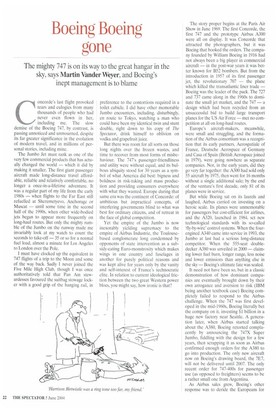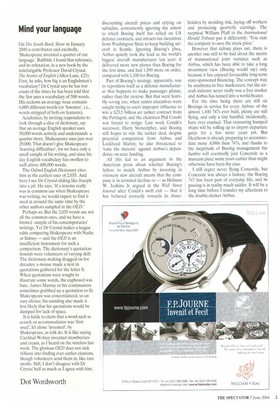Boeing Boeing gone
The mighty 747 is on its way to the great hangar in the sky, says Martin Vander Weyer, and Boeing's inept management is to blame Concorde's last flight provoked tears and eulogies from many thousands of people who had never even flown in her, including me. The slow demise of the Boeing 747, by contrast, is passing unnoticed and unmourned, despite its far greater significance in the evolution of modern travel, and in millions of personal stories, including mine.
The Jumbo Jet must rank as one of the very few commercial products that has actually changed the world — which it did by making it smaller. The first giant passenger aircraft made long-distance travel affordable, reliable and relatively comfortable, no longer a once-in-a-lifetime adventure. It was a regular part of my life from the early 1980s — when flights to the Far East still refuelled at Sheremetyevo, Anchorage or Muscat — until some time in the second half of the 1990s. when other wide-bodied jets began to appear more frequently on long-haul routes. But only the mighty rumble of the Jumbo on the runway made me invariably look at my watch to count the seconds to take-off —35 or so for a normal fuel load, almost a minute for Los Angeles to London over the Pole.
I must have clocked up the equivalent in 747 flights of a trip to the Moon and some of the way back. Sadly I never joined the Five Mile High Club, though 1 was once authoritatively told that Pan Am stewardesses favoured the suitbag stowage locker with a good grip of the hanging rail, in preference to the contortions required in a toilet cubicle. I did have other memorable Jumbo encounters, including, disturbingly, en route to Tokyo, watching a man who could have been my identical twin and stunt double, right down to his copy of The Spectator, drink himself to oblivion on vodka and grapefruit juice.
But there was room for all sorts on those long nights over the frozen wastes, and time to recover from most forms of misbehaviour. The 747's passenger-friendliness and utility were without equal, and its bulbous ubiquity stood for 30 years as a symbol of what America did best: bigness and boldness in risk-taking and mass production and providing consumers everywhere with what they wanted. Europe during that same era was the continent of Concorde: of ambitious but impractical concepts, of interfering governments blind to what was best for ordinary citizens, and of retreat in the face of global competition.
Yet the empire of the Jumbo is now inexorably yielding supremacy to the empire of Airbus Industrie, the Toulousebased conglomerate long condemned by opponents of state intervention as a subsidy-eating Euro-monstrosity which makes wings in one country and fuselages in another for purely political reasons and was kept alive for years only by the vanity and self-interest of France's technocratic elite. In relation to current ideological friction between the two great Western power blocs, you might say, how ironic is that? The story proper begins at the Paris Air Show in June 1969. The first Concorde, the first 747 and the prototype Airbus A300 were all on display. It was Concorde that attracted the photographers, but it was Boeing that booked the orders. The company founded by William Boeing in 1916 had not always been a big player in commercial aircraft — in the post-war years it was better known for B52 bombers. But from the introduction in 1957 of its first passenger jet, the revolutionary 707 — the plane which killed the transatlantic liner trade — Boeing was the leader of the pack. The 727 and 737 came along in the 1960s to dominate the small jet market, and the 747 — a design which had been recycled from an unsuccessful bid to build large transport planes for the US Air Force — met no competition at all on long-haul routes.
Europe's aircraft-makers, meanwhile, were small and struggling, and the formation of the Airbus consortium was a recognition that its early partners, Aerospatiale of France, Deutsche Aerospace of Germany and Casa of Spain (British Aerospace joined in 1979), were going nowhere as separate companies. Nor, in the early years, did they go very far together: the A300 had sold only 55 aircraft by 1975, then went for 16 months without a single additional sale; by the end of the venture's first decade, only 81 of its planes were in service.
But while Boeing sat on its laurels and laughed, Airbus carried on investing on a heroic scale. Its planes were unmemorable for passengers but cost-efficient for airlines, and the A320, launched in 1984, set new technological standards with its so-called 'fly-by-wire' control systems. When the fourengined A340 came into service in 1993, the Jumbo at last had a serious long-distance competitor. When the 555-seat doubledecker A380 was unveiled in 2000 — claiming lower fuel burn, longer range, less noise and lower emissions than anything else in the sky — Boeing's ultimate fate was sealed.
It need not have been so, but in a classic demonstration of how dominant companies are eventually brought down by their own arrogance and aversion to risk (IBM being another textbook case) Boeing completely failed to respond to the Airbus challenge. When the 747 was first developed in the mid-1960s, Boeing literally bet the company on it, investing S1 billion in a huge new factory near Seattle. A generation later, when Airbus started talking about the A380, Boeing retorted complacently by announcing the 747X Super Jumbo, fiddling with the design for a few years, then scrapping it as soon as Airbus confirmed enough orders for the A380 to go into production. The only new aircraft now on Boeing's drawing board, the 7E7, will not be delivered until 2007. The only recent order for 747-400s for passenger use (as opposed to freighters) seems to be a rather small one from Argentina.
As Airbus sales grew, Boeing's other response was to deride the Europeans for discounting aircraft prices and relying on subsidies, conveniently ignoring the extent to which Boeing itself has relied on US defence contracts, and attracts tax incentives from Washington State to keep building aircraft in Seattle. Ignoring Boeing's jibes, Airbus quietly took the lead as the world's biggest aircraft manufacturer last year: it delivered more new planes than Boeing for the first time, and had 1,500 more on order, compared with 1,100 for Boeing.
Part of Boeing's strategy, apparently, was to reposition itself as a defence manufacturer that happens to make passenger planes, rather than the reverse. But that went horribly wrong too, when senior executives were caught trying to exert improper influence to win a $23.5 billion air tanker contract from the Pentagon, and the chairman Phil Condit was forced to resign. Last week Condit's successor, Harry Stonecipher, said Boeing still hopes to win the tanker deal, despite potential competition from Airbus and Lockheed Martin; he also threatened to 'raise the rhetoric' against Airbus's dependence on state funding.
All this led to an argument in the American press about whether Boeing's failure to match Airbus by investing in visionary new aircraft means that the company is in terminal decline or — as Holman W. Jenkins Jr argued in the Wall Street Journal after Condit's swift exit — that it has behaved correctly towards its share holders by avoiding risk, laying off workers and protecting quarterly earnings. The sceptical William Pfaff in the International Herald Tribune put it differently: 'You ruin the company to save the stock price.'
However that debate plays out, there is another one still to be had about the merits of transnational joint ventures such as Airbus, which has been able to take a long investment view (Boeing would say) only because it has enjoyed favourable long-term state-sponsored financing. The concept may be anathema to free marketeers, but the aircraft industry never really was a free market and Airbus has turned into a world-beater.
For the time being there are still six Boeings in service for every Airbus: of the almost 1,400 747s ever built, plenty are still flying, and only a tiny handful, incidentally, have ever crashed. That reassuring humped shape will be rolling up to airport departure gates for a few more years yet. But Heathrow is already preparing to accommodate more A380s than 747s, and thanks to the ineptitude of Boeing management the Jumbo will eventually join Concorde as a museum piece some years earlier than might otherwise have been the case.
I still regret never flying Concorde, but Concorde was always a fantasy: the Boeing 747 has been part of everyday life, and its passing is in reality much sadder. It will be a long time before I transfer my affections to the double-decker Airbus.











































































 Previous page
Previous page